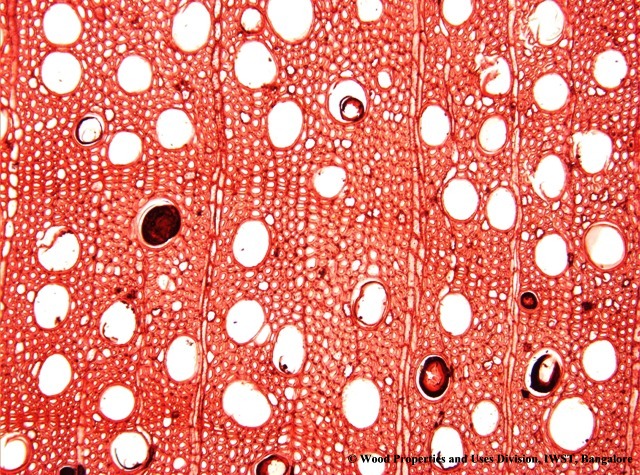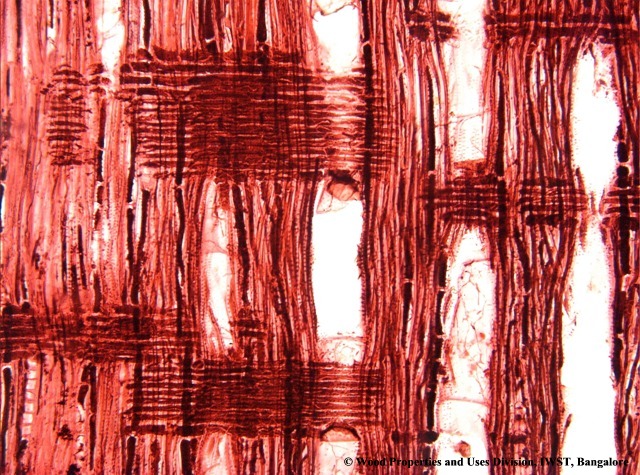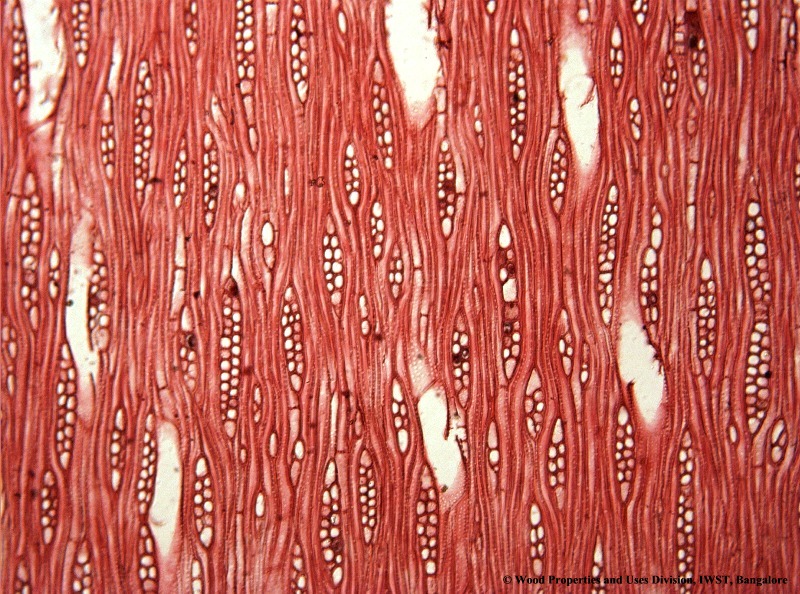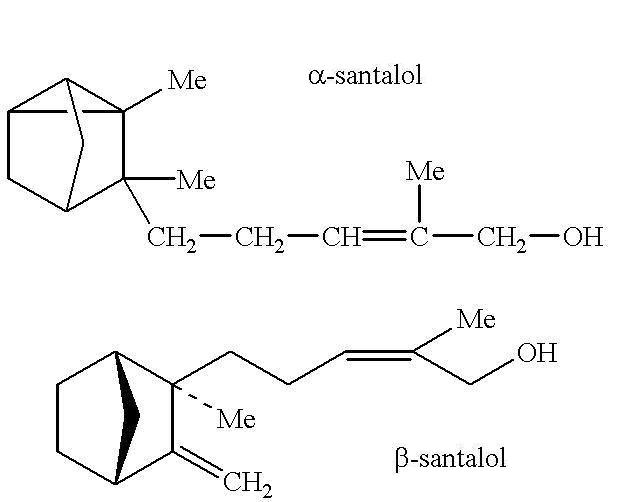Sandalwood Properties
 |
| Santalum album Linn. Cross Section |
 |
| Santalum album Linn. Radial Section |
 |
| Santalum album
Linn. Tangential Section Photos Courtesy: Wood Properties and Uses Division, IWST, Bangalore |
Cross Structure: A diffuse-porous wood. Growth rings indistinct to distinct, 2 per cm. Vessels/Pores small to very small, numerous (35-46 per mm2), evenly distributed, exclusively solitary, sllmetimes filled with brown deposits, round to oval in outline. Parenchyma/Soft tissues not visible to the eye. Rays fine to very fine, closely spaced, uniformly distributed, ray flecks present on the radial surface.
Minute Structure: Vessels upto 91 µm (mean 66 ± 1 µm) in diameter, perforation plate simple, intervascular pitting round, alternate, 6-7 µm in diameter, pits leading to rays are more of less similar to inlervascular pitting; 199-525 µm (mean 348 ± 4 µm) in length, truncate of abruptly tailed at one or both ends, orange-brown gummy deposits present. Parenchyma predominantly apotracheal, diffuse as Scattered few cells or in aggregates, brownish-yellow oily infiltration present, parenchyma strands composed of 2-4 cells, sometimes subdivides into crystaliferous locules eaeh containing solitary crystal. Fibres mostly angular, not radially aligned in cross section, average maximum diameter and wall thickness 19 µm and 5.5 µm respectively; 507-1611 µm (mean 1204 ± 9 µm) long; interfibre pitting bordered confined to radial and tangential walls, fibre tracheids present. Rays 1-2 seriate, 10-12 per mm (t), heterogeneous; (i) uniseriate rays, about 8 µm in width and upto 7 cells or 118 µm in height, composed of either entirely procumbent cells or mixed square and procumbent cells; (ii) biseriate rays, about 25µm in width and up to 17 cells or 315µm in height, composed of procumbent cells with single marginal row of square cells, pinkish brown infiltration present in the rays cells.
Sapwood and heartwood are distinct. Sapwood white; heartwood yellowish-brown with very pleasant characteristic scent; heavy to very heavy, air-dry weight 860-910 kg/ m3 (53-57 Ib/ft3). Straight or occasionally slight wavy grained, very fine and even textured.
Heartwood of Santalum album is moderately hard, heavy, and strongly scented and yellow or brown in colour. Sandalwood being close grained and amenable to carving, is one of the finest woods for the purpose. It is used in making idols and inlay ivory work. Such work is done on cottage industry scale.
Powder of heartwood upon steam distillation yields Sandalwood oil. The oil content varies from 3% - 6%. Light coloured wood generally contains higher percentage of oil than dark coloured.

Characteristics and Composition of Sandal Oil
Ø Colourless to golden yellow viscous liquid.
Ø Sp.Gr.0.962-0.985
Ø Alcohol content – Santalos > 90%
Ø Refractive index at 20oC = 1.504
Ø Solubility in 70% alcohol 1:5 volumes
Ø Optical rotation 19o-20o
Ø Acid value – 1.9-2.2
Ø Ester value – 13-16
Ø Ester value after acetilation – 210-215
Ø Ester content 1.6-5.4%
| Chemical Components | Parts Used for extraction |
| (E)-5-(2,3-DIMETHYL-3-NORTRICYCYL)-PENT-3-EN-2-ONE | Wood |
| (E)-ALPHA-SANTALAL | Wood |
| (E)-BETA-SANTALAL | Wood |
| 1-ALLOHYDROXYPROLINE | Fruit |
| 1-FURFURYL-PYRROLE | Wood |
| 1-METHOXY-4-ALLYL-GUAIACOL | Wood |
| 11-METHYL-7-OXA-TETRACYCLODODECANE | Plant |
| 2-METHYL-3-METHYLENENORBORNAN-2-OL | Plant |
| 2-METHYL-3-METHYLENENORBORNAN-2-OL | Plant |
| 4-(P-TOLYL)-VALERALDEHYDE | Wood |
| 4-ETHYL-GUAIACOL | Wood |
| 4-METHYL-CYCLOHEX-3-EN-1-YL-METHYL-KETONE | Wood |
| 4-METHYL-CYCLOHEXA-1,3-DIEN-1-YL-METHYL-KETONE | Wood |
| 4-METHYL-GUAIACOL | Wood |
| 4-VINYL-GUAIACOL | Wood |
| 4-VINYL-PHENOL | Wood |
| 5,6-DIMETHYL-5-NORBORNEN-EXO-2-OL | Wood |
| ALANINE | Fruit |
| ALPHA-CURCUMENE | Wood |
| ALPHA-SANTALENE | Wood |
| ALPHA-SANTALIC-ACID | Wood |
| ALPHA-SANTALOL | Wood |
| ALPHA-TERPINEOL | Wood |
| ASPARAGINE | Fruit |
| BETA-CURCUMENE | Wood |
| BETA-FARNESENE | Wood |
| BETA-SANTALENE | Wood |
| BETA-SANTALIC-ACID | Wood |
| BETA-SANTALOL | Wood |
| BETA-SITOSTEROL | Fruit |
| BETULIC-ACID | Fruit |
| BORNEOL | Wood |
| CITRONELLOL | Wood |
| D-10-HYDROXY-PALMITONE | Wax |
| ENDO-2-ENDO-3-DIMETHYL-NORBORNAN-EXO-2-OL | Wood |
| ENDO-2-METHYL-3-METHYLIDENE-NORBORNAN-EXO-2-OL | Wood |
| Essential Oil (EO) | Root 100,000 ppm; Wood 15,000 - 62,500 ppm |
| EPI-BETA-SANTALENE | Wood |
| EUGENOL | Wood |
| EXO-NORBICYCLOEKASANTALAL | Plant |
| FAT | Seed 500,000 - 600,000 ppm |
| FRUCTOSE | Fruit |
| GAMMA-SANTALIC-ACID | Wood |
| GERANIOL | Wood |
| GLUCOSE | Fruit |
| GUAIACOL | Wood |
| ISOEUGENOL | Wood |
| ISOVALERALDEHYDE | Wood |
| L-SANTENONE | Wood |
| LACTONE | Wood |
| LINOLEIC-ACID | Fruit |
| LYSINE | Fruit |
| N-OCTACOSANOL | Wax |
| N-TRIACONTANOL | Wax |
| NORTRICYCLOEKASANTALAL | Wood |
| NORTRICYCLOEKASANTALENE | Wood |
| NORTRICYCLOEKASANTALIC-ACID | Wood |
| NORTRICYCLOEKASANTALOL | Wood |
| O-CRESOL | Wood |
| OCTADEC-11-EN-9YN-ACID | Fruit |
| OLEIC-ACID | Fruit |
| P-CRESOL | Wood |
| P-METHYL-ACETOPHENONE | Wood |
| PALMITIC-ACID | Fruit |
| PALMITONE | Wax 440,000 ppm |
| PHENOL | Wood |
| PROLINE | Fruit |
| RESIN | Wood 50,000 - 80,000 ppm |
| SANTALAL | Wood |
| SANTALBIC-ACID | Seed |
| SANTALOL | Root 95,900 ppm; Wood 13,500 - 61,250 ppm |
| SANTALONE | Wood |
| SANTENE | Wood |
| SANTENOL | Wood |
| SERINE | Fruit |
| STEAROLIC-ACID | Seed |
| SUCROSE | Fruit |
| TANNIN | Wood |
| TERESANTALAL | Wood |
| TERESANTALIC-ACID | Wood |
| TERESANTALOL | Wood |
| TERESANTANOL | Wood |
| TRICYCLOEKASANTALIC-ACID | Wood |
| TRICYCLOEKASANTALOL | Plant |
Reference:
Ø Duke, James A. 1992. Handbook of phytochemical constituents of GRAS herbs and other economic plants. Boca Raton, FL. CRC Press.
Ø Agrawal, S.P., & Pande, P.K., Anatomy of Commercial Timbers of South Zone, Part –II, Indian Forest Records, Vol. 4, Wood Anatomy, No. 3
Ø http://www.frienvis.nic.in/WriteReadData/UserFiles/file/pdfs/Sandal.pdf viewed 12th August 2015.



